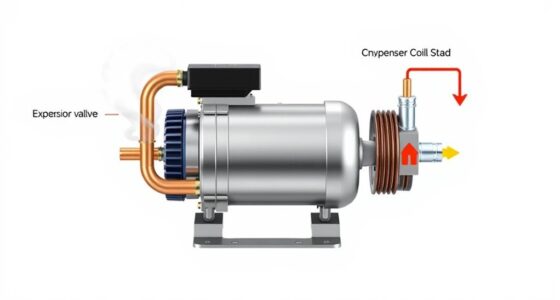We presumed refrigeration’s sole purpose was to maintain cool temperatures, yet we were largely unaware of its covert impact on the environment.
The refrigeration cycle, with its leakage and waste, is wreaking havoc on our planet. From energy consumption to ozone depletion, and global warming potential, it’s time we face the truth.
In this article, we will delve into the impacts and challenges of the refrigeration cycle, shedding light on the urgent need for sustainable solutions.
Let’s serve our environment by understanding the true cost of our cold comforts.

Key Takeaways
- Refrigerant leakage contributes to global warming and ozone layer depletion, leading to adverse environmental impacts.
- Maximizing energy efficiency through efficient technologies and practices can significantly reduce the energy consumption of refrigeration systems.
- Transitioning to ozone-friendly alternatives and refrigerants with lower Global Warming Potential (GWP) is crucial for environmental sustainability.
- Proper waste management and disposal practices, including recycling and responsible end-of-life management, are necessary to mitigate the environmental challenges posed by refrigeration systems.
Impacts of Refrigerant Leakage
We need to acknowledge the significant impacts of refrigerant leakage on our environment. Not only does it have detrimental effects on the ozone layer, but it also contributes to global warming. Refrigerants contain greenhouse gases, such as hydrofluorocarbons (HFCs), which are known to have a high global warming potential. When these gases leak into the atmosphere, they trap heat and contribute to the overall increase in temperatures.
This not only has environmental consequences but also poses health risks to humans. Exposure to leaked refrigerants can lead to respiratory problems, skin irritations, and even neurological disorders.
Additionally, the cost implications of refrigerant leakage are substantial. Companies and individuals have to bear the expenses of repairing leaks and replenishing lost refrigerants, which can be a significant financial burden.
It’s crucial to address this issue by implementing proper maintenance protocols and adopting more sustainable refrigeration practices.

Energy Consumption and Efficiency
Our goal is to maximize energy efficiency while minimizing energy consumption in the refrigeration cycle. Energy conservation is crucial in reducing the environmental impact of refrigeration systems. By employing efficient technologies and practices, we can significantly decrease the amount of energy required to operate these systems.
One way to achieve this is through the use of renewable resources, such as solar or wind power, to generate the electricity needed for refrigeration. Additionally, optimizing the design and maintenance of refrigeration equipment can further enhance energy efficiency. This includes proper insulation, regular maintenance, and the use of energy-efficient components.
By focusing on energy conservation and utilizing renewable resources, we can minimize the energy consumption of refrigeration cycles, reducing their overall environmental footprint.
Transitioning to the subsequent section about ‘ozone depletion potential’, it’s important to consider the impact of refrigeration systems on the ozone layer.

Ozone Depletion Potential
When discussing the ozone depletion potential of refrigeration systems, it’s important to understand the impact of certain refrigerants on the ozone layer. The ozone layer, a protective shield in the Earth’s atmosphere, plays a crucial role in filtering out harmful ultraviolet (UV) radiation from the sun.
However, certain refrigerants, such as chlorofluorocarbons (CFCs) and hydrochlorofluorocarbons (HCFCs), have been found to contribute to the depletion of the ozone layer. These substances contain chlorine and bromine atoms, which can break down ozone molecules, leading to a thinning of the ozone layer.
To protect the ozone layer, environmental regulations have been put in place to phase out the production and use of ozone-depleting substances. These regulations aim to promote the use of ozone-friendly alternatives, such as hydrofluorocarbons (HFCs) and natural refrigerants.
Transitioning to these safer alternatives is crucial for ozone layer protection and the sustainability of our environment. Moving forward, it’s important to also consider the global warming potential of refrigerants.

Global Warming Potential
To understand the impact of refrigeration systems on global warming, it’s important to consider the global warming potential of different refrigerants. Global warming potential (GWP) is a measure of how much a particular gas contributes to global warming over a specific time period, usually 100 years. Refrigerants, such as hydrofluorocarbons (HFCs), have high GWP values, meaning they have a significant impact on global warming.
In recent years, there has been a growing concern about the environmental impact of HFCs, leading to the development of emissions reduction strategies and the search for alternative refrigerants with lower GWP. These alternative refrigerants, such as hydrofluoroolefins (HFOs) and natural refrigerants like ammonia and carbon dioxide, have lower GWP values and are considered more environmentally friendly.
By transitioning to these alternative refrigerants, we can reduce the greenhouse gas emissions from refrigeration systems and mitigate their contribution to global warming. Understanding the global warming potential of refrigerants is crucial in implementing effective emissions reduction strategies and transitioning to more sustainable refrigeration technologies.
With this knowledge, we can now delve into the next important aspect of refrigeration systems: waste management and disposal challenges.

Waste Management and Disposal Challenges
We face significant challenges in managing and disposing of waste generated by refrigeration systems. To address these challenges, waste reduction strategies and recycling initiatives are being implemented.
Here are four key considerations:
-
Proper waste segregation: It’s crucial to separate different types of waste, such as refrigerants, oils, and metals, to ensure effective recycling and disposal.
-
Safe storage and transportation: Proper containment and transportation methods are essential to prevent leaks and spills that can harm the environment and human health.

-
Recycling and recovery programs: Initiatives to recover and recycle refrigerants, oils, and other components from discarded systems are vital to minimize waste and reduce environmental impact.
-
End-of-life management: Developing comprehensive protocols for the proper disposal of refrigeration systems is essential to prevent hazardous substances from entering landfills and to promote responsible waste management.
Frequently Asked Questions
What Are the Main Health Risks Associated With Refrigerant Leakage?
The main health risks associated with refrigerant leakage include respiratory problems, skin irritation, and eye irritation. Additionally, these leaks contribute to the environmental impact of global warming and ozone depletion.
How Do Refrigeration Systems Contribute to Air Pollution?
Refrigeration systems contribute to air pollution through refrigerant emissions, which have a significant environmental impact. These emissions release harmful substances into the atmosphere, contributing to climate change and ozone depletion.

Can Energy-Saving Measures Be Implemented to Reduce the Energy Consumption of Refrigeration Systems?
Yes, energy-saving measures can be implemented to reduce the energy consumption of refrigeration systems. By incorporating techniques such as improving efficiency and optimizing settings, we can significantly reduce the environmental impact of these systems.
Are There Alternative Refrigerants Available That Have Lower Ozone Depletion Potential?
Refrigerant alternatives with lower ozone depletion potential can significantly reduce the environmental impact of refrigeration systems. Implementing these alternatives is an effective way to mitigate the hidden assault on our environment caused by the refrigeration cycle.
What Are the Current Waste Management and Disposal Practices for Refrigeration Systems, and What Challenges Do They Pose?
The current waste management and disposal practices for refrigeration systems present significant challenges. These practices need to address the environmental impact and find solutions to mitigate the negative effects on our planet.
Conclusion
In conclusion, the refrigeration cycle has a significant impact on our environment. One interesting statistic is that refrigerant leakage accounts for approximately 14% of global greenhouse gas emissions, contributing to climate change.

It’s crucial that we prioritize energy efficiency and proper waste management to mitigate these harmful effects. By making informed choices and adopting sustainable practices, we can minimize the hidden assault of refrigeration on our environment and work towards a greener future.









